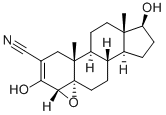The use of trilostane in dogs
Feb 28,2024
Description
Trilostane, a competitive inhibitor of 3β-hydroxysteroid dehydrogenase (3β-HSD), is an FDA-approved drug for the treatment of canine pituitary-dependent hyperadrenocorticism (PDH) and adrenal hyperadrenocorticism (ADH)[1]. Trilostane provides a pharmacological alternative to surgical adrenalectomy or hypophysectomy. Unlike mitotane (o,p’-DDDD, Lysodren), trilostane is the only approved drug targeting both pituitary- and adrenal-related hyperadrenocorticism in dogs.
Biological activity
Studies in other species have demonstrated that trilostane not only inhibits 3β-HSD but also has additional inhibitory effects on steroid biosynthesis. The enzyme 11β-hydroxysteroid dehydrogenase (11β-HSD) catalyzes the interconversion of physiologically active cortisol and inactive cortisone and is known to exist as different isoenzymes, two of which have been identified in humans: type 1 (11β-HSD1) mainly converts cortisone to cortisol, while type 2 (11βHSD2) converts cortisol/cortisone[2].
Clinical uses

Trilostane is used to treat Cushing’s Disease in dogs and cats. Trilostane decreases the production of excessive cortisol hormone by the adrenal gland. This disease is not cured by trilostane but can be managed successfully. Trilostane also may be used to treat Cushing’s disease in cats. Cushing’s disease is rare in the cat and may not respond well. Frequently, cats with Cushing’s disease also have underlying diabetes mellitus. Trilostane does not appear to change their insulin requirements.
Trilostane is currently available in 5 mg, 10 mg, 30 mg, 60 mg, and 120 mg capsules, but lower doses might be more appropriate for treating small breed dogs. Compounding FDA-approved veterinary medications is an accepted practice to assist in achieving lower doses. Cook et al. (2012) investigated commercial compounded trilostane capsules, determining that 38% of the batches tested (36 of 96) fell below the acceptance criteria for drug content. Additionally, 20% of the batches tested failed dissolution testing, defined as ≥70% dissolution within 75 min.
Side effects
The more common side effects include loss of appetite, lethargy, weakness, vomiting, and diarrhea. Rarely have fatalities been reported. Very rarely, trilostane can cause the adrenal gland to stop functioning totally. If this occurs, the change is permanent, and your animal must be on lifelong supplementation of corticosteroids and mineralocorticoids.
References
[1] Jesse Crosby, Stacy Brown. “Stability of compounded trilostane suspension in cod liver oil.” Veterinary journal 228 (2017): Pages 15-17.
[2] Takahiro Teshima. “Expression of 11β-hydroxysteroid dehydrogenase isoforms in canine adrenal glands treated with trilostane.” Veterinary journal 200 3 (2014): Pages 452-455.
- Related articles
- Related Qustion
- Synthesis and Biological Activity of Trilostane Sep 14, 2022
Trilostane can inhibit 3β-dehydrogenase in the process of corticosteroid synthesis, reduce the synthesis of cortisol and aldosterone.
PVB offers excellent glass adhesion and UV resistance, while PVB-based nanofiber yarns with CuO and V2O5 nanoparticles show promising antibacterial efficacy for diverse applications.....
Feb 28,2024APISalt water, the vast expanse of saline solution covering approximately 71% of the Earth's surface, is a remarkable substance that plays a pivotal role in the planet's ecosystem.....
Feb 28,2024APITrilostane
13647-35-3You may like
- Trilostane
-

- $0.00 / 25Kg/Bag
- 2024-05-27
- CAS:13647-35-3
- Min. Order: 2Kg/Bag
- Purity: 99% up, High Density
- Supply Ability: 20 tons
- Trilostane
-

- $10.00/ kg
- 2024-04-24
- CAS:13647-35-3
- Min. Order: 1kg
- Purity: 99.8%
- Supply Ability: 10000ton
- Trilostane
-

- $0.00 / 25kg
- 2024-04-12
- CAS:13647-35-3
- Min. Order: 1kg
- Purity: 99%
- Supply Ability: 2000ton




